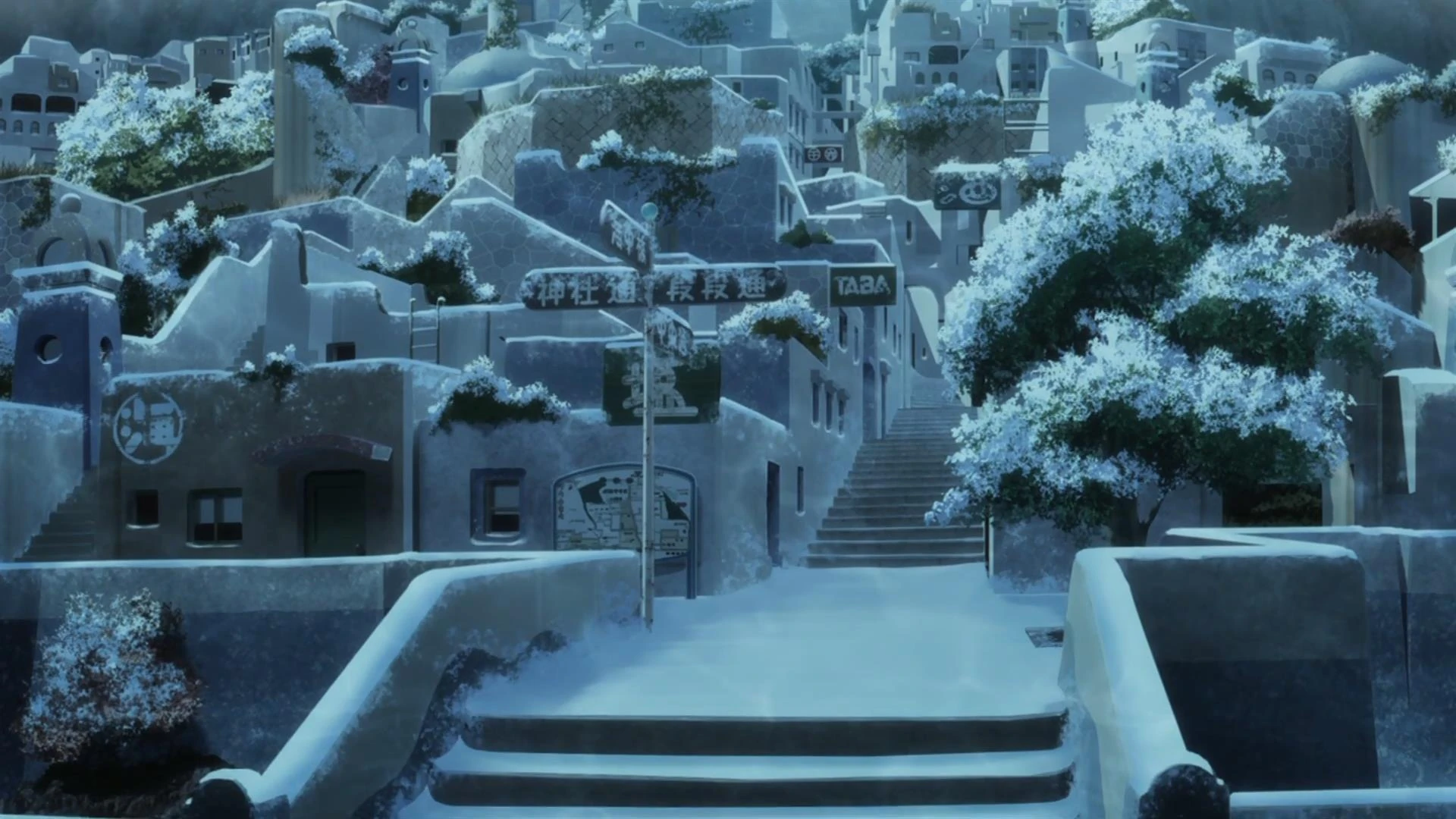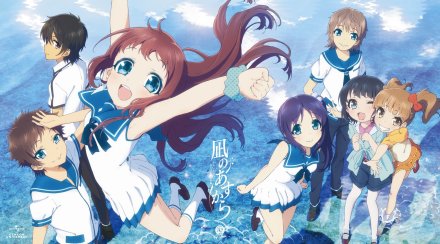A spoiler-free review of the 2013-2014 anime “Nagi no Asukara” or “Nagi-Asu: A Lull in the Sea,” produced by P.A. Works.
I will sacrifice all of my worldly possessions if I could live in Shioshishio for a year. In fact, Umigami, just take my soul. I’ll even be the Ojoshi-sama if it means visiting this dreamlike underwater village. Please, give me Ena ~

Shioshishio, the enchanting undersea village
Since the dawn of humanity, civilization had lived on the ocean floor. As curiosity tugged at their legs (or fins), however, several humans migrated to the land, which caused a huge splintering in lifestyles. Upon their undersea school closing, Hikari, Manaka, Chisaki, and Kaname – four 14-year-old middle school kiddos – are forced to eke out education on land and adapt to the unfamiliar environment. They aren’t alone in terms of emotional struggle, though. Three surface kids – Tsumugu, Miyuna, and Sayu – must also confront their feelings before the whole lot grows older, and the rift between the sea and the land, old and young, tears the two parties apart.
It should become clear right off the bat that we’re dealing with seven individuals, which means in terms of coupling someone will be left out. As dramatic as that sounds, Nagi-Asu manages to keep a level head, never allowing said drama to grow out of hand nor become overbearing. That’s not to say that the show is lighthearted, though! Uh, no, it’s got just the right amount of spice, but in that way, has its own way of plucking your heart strings, and thankfully it doesn’t ever snap them. The anime incorporates themes of love by using slice-of-life tactics, and it overwhelmingly succeeds on this front.

See, love – it’s easy as Hikari loves Manaka, but Manaka falls in love with Tsumugu, though Chisaki might have a crush on Hikari, but Kaname is already in love with Chisaki, and . . .
Oh the water physics – don’t try to wrap your head around it. Just admire its subtle beauty and convenience . . . writing on paper, running around, boiling food on the ocean floor . . . What is this, SpongeBob!?
But moreover, once the drama wave sinks back into the ocean, we are left with a story about innocent crab children crawling out of their shells to deliver their unrequited love to one another. Because the characters are so unexperienced with the notion, and have even grown up together in the local village, it’s vital to pay attention to each of their reactions to the sudden emotional turns taken in the series. Thankfully, the animation directors have a very keen eye for these delicate matters, and display facial expressions with such passion! Props to the VAs, too, for putting up equally impressive vocal performances, especially Hanae Natsuki’s youthful role as Hikari and Kana Hanazawa’s adorable Manaka!

Let’s talk about those characters now. I’ll admit, they’re a great, well-developed bunch, but the only one whom particularly snatched my attention was the main character himself, Hikari Sakishima. Born ‘n raised in the deep blue, he harbors a distinct hate towards the land people. Specifically speaking, he loathes the silent but strong Tsumugu for him loving his little Manaka – or rather, Manaka sneaking a peak at this dark-tanned land dweller. Underneath his layers of stubbornness, Hikari prematurely believed that he and Manaka were an assumed pairing. Manaka has other plans. Throughout the series, Hikari struggles with his passive relationship with his other friend, Chisaki, and we witness him grow from a boy to a man (kinda sorta, not physically at least :3)!
I have much to say about the art and animation, but it’d do you justice to simply marvel at the “environmental porn” surrounding the sea village itself and its sister harbor above. The animators always use the color blue. In fact, it’s in every frame of the series. Sharply contrasting the magnificent hue is orange, blue’s complementary color. Whether it be the rust on the boats moored at the dock or the land school’s uniforms, orange manages to cancel out blue’s magic. Not only is it smart cinematography, but the most effective. Nagi-Asu is truly is the prettiest anime series I have ever seen!




There’s only one word to describe this OST: Heart. It has a lot of heart. While lively guitar strums out the cheerful opening tone, fitting for the youthful boasts of Hikari, a bittersweet piano slides in to caress the emotional moments featured in the series. “Cry for the Moon,” “Tears of the Sea,” “Prayer,” “Solitude,” and “The Ofunehiki Song” are the best examples of this mood. I could listen to this soundtrack for hours on end, but then only feel depressed that I spent so much time out of the water’s embrace 🙂
To add to the praise, I must admit that both of Ray’s openings, “lull ~Soshite Bokura wa~” and “ebb and flow” are so incredibly fitting for the undersea atmosphere! They make me want to swim around in cool, clear waters with all of my friends. But we can’t forget “Aqua Terrarium” by Nagi Yanagi, the first ending, which depicts the cold, deep blue ocean floor with a frozen Manaka.
It would be a crime to not watch Nagi-Asu. The art is divine and animation of this quality is rare to come by! Always, the story kept me intrigued, and the romance between the characters tied the package all together! But I can’t help but regret the switch to the above ground in the second half, especially when they had so much going for them down where it was wetter. So much life; carefree days of youth. The surface is a bitter cold. Adults struggle to make a living, and kids don’t have as near wide of smiles as the Shioshishio squad. Growing up and realizing your feelings, whether they are for others or nature, was a deeply felt theme in the anime. However much I disliked the change, the two halves of the series were the twin tides that brought the message in the bottle to the salty shore; truthfully, both were needed.
“Having feelings for someone just brings sorrow to someone else. Someone always gets sacrificed and suffers. If this is what it means to fall in love . . . then falling in love is terrible.” – Hikari Sakishima
+ Story felt fresh; romance and drama were never too overbearing, but enough to convey true feelings of love
+ Characters were very well-developed and entertaining, notably Hikari and maybe Chisaki
+ Themes of old vs. young, love of people vs. nature were demonstrated with a content satisfaction
+ UNDER THE FREAKIN’ SEA, absolutely stellar art and consistent superior animation quality
+ A rich OST full of heart, appropriate instruments to enhance the mood
– Switch from underwater to above land was somewhat disappointing
– A few interfering elements to the story were ‘too’ supernatural

I have returned to anime reviews! Do you prefer this new format over the previous one? It’s a work in progress, but I’m trying to find a style I’m completely satisfied with. Did you have similar thoughts about this under-the-sea fantasy drama/rom-com? Different? For the café menu, Nagi-Asu receives a solid 9/10, and I strongly recommend you watch this show on Crunchyroll – and it’s free of all things, so no excuses! If you enjoyed the review, feel free to caress that like button like a red-bellied sea slug, as that’ll let me know if you like my content! Ah, how grand it feels to be back to these reviews ~ Until next time everyone, this has been
– Takuto, your host


